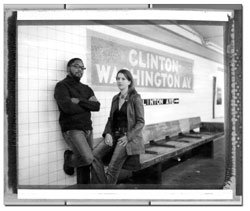| ||
Getting your grub on by Chef Boy Ari Anna Lappé hails from a family of food activists. Her mother, Frances Moore Lappé, wrote the classic Diet for a Small Planet, which argued that world hunger is an issue of justice and distribution, not production. Her father, Marc, was a high-powered campaigner against toxins in food and corporate injustice, as well as a professor of ethics. Anna’s new book is called Grub: Ideas for an Urban Organic Kitchen, co-authored with artist, chef and activist Bryant Terry. It’s something of a handbook for eating well in an urban environment, with advice on shopping, kitchen arrangement, food storage, recipes and menus, and even soundtracks for cooking. Grub also goes into detail, with numerous citations of scientific studies and relevant factoids, about why a diet of local, seasonal, organic, fair-trade, minimally processed food is better for you, the planet and your fellow beings. Maybe it’s my gossip-prone imagination, but you just can’t help wondering if Anna and Bryant are getting more than just their grub on. The author’s photo of them together in a subway station makes you wonder if their legs are touching, and there are a few tantalizing hints buried in the text. It reminds me of listening to Beetles songs backwards, and scrutinizing the cover of Sgt. Peppers Lonely Hearts Club Band searching for “Paul is dead” clues. Meanwhile, I was happy to find Grub addressing a question that’s nagged me for a while: what’s the big deal with corn syrup? I mean, I enjoy maple syrup, brown-rice syrup, molasses and other plant syrups. Corn is sweet, so why not make syrup out of it? It turns out that the industry standard high-fructose corn syrup is not made by some old-fashioned stove-top process, but from numerous manipulations in the laboratory. It’s not even made from sweet corn, but a high-starch variety, and the high-fructose product is handled differently than glucose by the human body, particularly the liver, resulting in weight gain, heart disease and ailments like irritable bowel syndrome. Meanwhile, high-fructose corn syrup – six times as sweet as sugar – is nearly unavoidable in most processed food, and thus ubiquitous in the American diet. Anna, already a best-selling author (Hope’s Edge, coauthored with her mother, was her first book), nonprofit executive (Small Planet Institute and Small Planet Fund) and in-demand speaker, is a busy lady. When I finally tracked her down by phone, she was waiting to give a speech at the Food for Thought Festival in Madison, Wisc. I asked her if she had any thoughts on the E. coli spinach scandal that’s recently erupted, killing a Wisconsin woman and landing more than 100 people in the hospital in more than 20 states. Some reports name organic spinach as the culprit.
“I’m afraid that the anti-organic PR machine is going to use this to pump up their mythology that organic foods are more dangerous,” she said. “As I point out in the book, E. coli of this variant was unheard of a few decades ago. We are faced with it only because of the irresponsible and unsafe practices of industrial farming, particularly of feedlot operations. The anti-organic folk like to trot out the fact that organic production uses manure for fertilizer, which to many people sounds gross. What they don’t mention are the strict regulations around the use of manure on organic farms (for example, composting the manure to a high-enough temperature to kill E. coli).” I also asked Anna if she had any advice for college students, stuck in their dorm rooms with their water boilers and their Top Ramen, who want to eat good grub. “I can’t say my diet at college was a paragon of Grub-ness either, “ she admitted, “but thankfully there are more and more campuses offering co-eds fresh, local, healthy foods now than in the early 1990s. “Half of my biggest advice for dorm dwellers is don’t try to go it alone: think about fun and creative ways to get friends on board. You can start buying and cooking clubs, share the burden of making healthy snacks, incorporate some time out on a farm or community garden into your routine. There are lots of things you can do, and certainly don’t beat yourself up for not getting it just how you’d like it all the time! “And take advantage of your school’s Farm to College program (in which locally grown food is integrated into campus menu options), if there is one – if there isn’t, lobby for one,” she added. “As one farm-to-college organizer put it: ‘Students shouldn’t be reading The Jungle in English 101 and then eating it for lunch.’” Finally, I inquired as to the most Grubin’ meal she likes to prepare. “I’m partial to all of Bryant’s menus in our book, Grub. My favorite dish is the ‘Wild Style Rice Salad’ (Author’s note: wink). I recommend following Bryant’s suggested soundtracks that he includes with the menus and checking out our website for downloadable shopping lists for each of the menus.” If you want to download Bryant’s “Wild Style Rice Salad,” as well as some more incriminating photos, visit www.eatgrub.org. •
|
In this week's issue...
- May 15, 2025
- End of the trail
Despite tariff pause, Colorado bike company can’t hang on through supply chain chaos
- May 8, 2025
- Shared pain
Dismal trend highlights need to cut usage in Upper Basin, too
- April 24, 2025
- A tale of two bills
Nuclear gets all the hype, but optimizing infrastructure will have bigger impact


